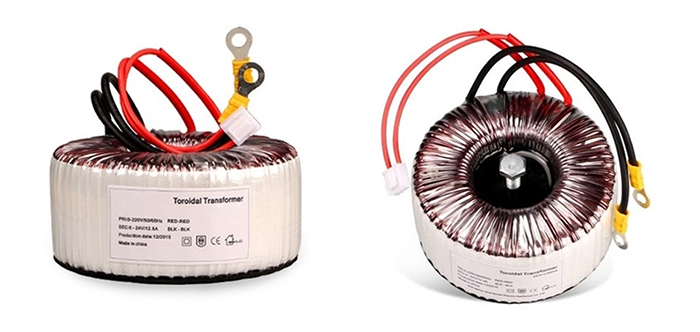How to Improve Efficiency of Toroidal Transformer?
Toroidal transformer is a kind of step-up & step-down transformer power supply, which has the advantages of small volume, low noise, less heat and high performance. Generally, we use a variety of voltages, such as 220V for domestic lighting, 36V for industrial safety lighting, and the voltage of the welding machine needs to be adjusted. These cannot be separated from the toroidal transformer, which can step down the voltage we need through the principle of electromagnetic mutual inductance of the main and auxiliary coils. But how to improve the conversion efficiency of toroidal transformers has been a problem for many people. In fact, the conversion rate of a toroidal transformer is determined by the transformer's power, production materials, and its work site.

The higher the power, the higher the efficiency
The larger the rated power of the transformer, the higher the working conversion efficiency. The same 220V to 24V transformer with a rated power of 500VA has a working conversion efficiency of more than 92%, while the conversion efficiency of 50VA low power is only 85%. There is a clear difference between the two.
All copper wire transformers have higher efficiency
All copper wire toroidal transformers have higher conversion efficiency than copper clad aluminum wire transformers and aluminum wire transformers. For the same type of toroidal transformer, if the metal wire used for its coil winding is aluminum, its loss will be greater than that with a copper coil. However, all copper wire transformers generate less heat and have less losses in the same time period. Naturally, the work conversion efficiency is faster than copper-clad aluminum wire transformers and aluminum wire transformers that generate heat and have large losses.
30 ℃ is the highest conversion temperature
The temperature of the working site of the toroidal transformer will also affect the conversion rate of the toroidal transformer. Currently, the temperature that makes the conversion rate reaches the highest is 30 ℃. When the ambient temperature exceeds 30 ℃, the toroidal transformer will reduce its own conversion rate because it accumulates too much heat inside. When the on-site temperature of the toroidal transformer rises by 20 ℃, its conversion rate will drop by 20%. When the temperature is 0 ℃, it can load 120% of the rated power. When the temperature is 50 ℃, the transformer can load 80% of the rated power. Therefore, when the temperature of the working environment is too high, we can increase the conversion rate of the toroidal transformer by adjusting the temperature below 30 °C through a temperature adjustment device. (If the environment is different, for example, the air mobility is different, the specific conversion efficiency of the transformer is slightly different)
Select the right core structure of transformer
The iron core of the toroidal transformer, cold-rolled silicon steel with a thickness of 0.35 mm or less, is seamlessly rolled. The coil is uniformly around the core, and the direction of the magnetic field lines caused by the core almost coincides with the core, so that the eddy current loss generated by the AC current through the coil is minimized. For example, the core loss of E-type transformers exceeds 50%, so as to improve the conversion efficiency of transformation or isolation, thus being often used in switching power supply solutions.
The core of the toroidal transformer can be deepened without air gap, which is a good choice for switching power supplies or power adapters. The stacking factor can be as high as 95%, and the core magnetic conductance can take 1.5 to 1.8 T. Therefore, the electrical conversion efficiency of the toroidal transformer can reach more than 95%. This is the core structure of the transformer without breath, which can make the reactive current very small, and there is no heat generation in the long-term power situation.

